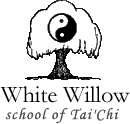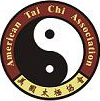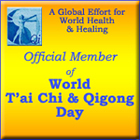The White Willow 'Style' of Tai Chi
I am often asked: "What ‘style' of Tai Chi do you teach?"
Before I can answer the question, I think a little discussion about what is a "style" is in order.
Over the last half century, this question has come to mean: "What is the name of the choreography of your form set?" Style has become dance choreography with names like Yang Style (referring to the form of Yang Chen Fu), Wu Style, The 48 Form, The 24 Form, and The Chen Style. Each of these has a form choreography that students learn,"push hands" duo choreography, and sometimes a sword choreography. All this choreography and only the slightest bit of function.
Styles were created by master fighters who took the universal movement principles of Tai Chi movement and combined them with their personal fighting experience, temperament, and body type to create an integrated fighting system. Every movement has multiple functions and all those functions are practiced with every movement.
Early styles were integrated systems of real techniques and principles. Each technique was learned individually and drilled until the flow and principles were ingrained into the organic system of the body. This training focuses on utility first and as the neural system grows so does depth of technical nuance and mental perception. Once ingrained, the techniques were "linked" in a logical manner that trained fighting sequences in their most likely probability of application. This logical sequencing is the most significant determining factor, which distinguishes the difference between early "authentic" Tai Chi forms and the later health, and fitness forms. Authentic forms are also practiced with the same frame (stance width and depth), timing and fluidity that would be used in actual application.
The visual elements of frame, timing, fluidity and sequencing of the "linking form" becomes the signature of the style. The form is the means of programming all the elements of the style into the student's nervous system. The practice of the form makes all applications completely reflexive, subconscious solutions to multiple opponent attacks.
Tai Chi has always been a living art. It is an art that is personalized by individuals to become their own. Think of Tai Chi form as a piece of music. Many people can play and record the song in their own personal way without changing the meaning. Once the meaning is changed, good or bad, the song is no longer in harmony with the intention of the creator. It is therefore, a new song. Like songs, there is no one single perfect Tai Chi style.
Masters of a particular style would choose students who had the greatest potential for understanding and propagating their art. In other words they chose students who were very much like them, physically, mentally and emotionally. Styles became an extended family with their own sub-culture of living. Each school within that style became its own individualized sect. And like all denominations of any art, religious defended their way of doing things. In this world that could mean duels to the death.
Today serious students chose their teachers by what they have been conditioned by various media and the inter-net. Tai Chi styles and teachers are more often than not, chosen because of popularity, hype, proximity and cost. Choosing in this manner is not a good idea.
Contrary to popular belief, Tai Chi movements and choreography do not inherently create healthy results. For this reason, medical studies have great difficulty accurately testing Tai Chi using good scientific method.
It is not the movements or the choreography that produce results. It is how the movements are practiced that produces results. How the movements are practiced is directly determined by how the movements are taught.
Ultimately the teacher, like any great coach, provides the means and methods that dictate the students' success. No amount of practice and dedication on the students part can overcome misinformation, mistakes, and misunderstandings that have been past on to them by their teachers. No lineage, certificate of style, or trophy case will guarantee competent instruction in Tai Chi. And unfortunately, with the removal of utility, more mistakes than ever are being passed on to students.
With the advent of firearms and centralized police and government in China, the need for fighting diminished. The focus upon health, spiritual attainment and aesthetics started to eclipse the martial focus of Tai Chi. Forms became larger to extend range of motion and muscular toning. Communism was the final transformational force upon Tai chi. Under the communist regime, masters were required to purge or deeply hide any martial application. Tai Chi was officially for health and fitness only. Because of its peaceful exterior and focus upon health, Tai Chi captured the imagination of the world. The notion of hundreds of people doing slow motions in a park was a wonderful symbol and metaphor of spiritual union. Relaxation of mind and body became the new goal of Tai Chi form. A goal that could easily be achieved with almost no technical skill or accuracy. With the exception of sport competition, all intention of utility and real technique within the form was lost.
Ironically, when the utility was withdrawn, the deepest conditioning and healing methods were lost as well. Form no longer followed function. Form became its own end. Without the proper application the vectors of the movements and flow of kinetic forces were changed destroying the "internal nature" of the art. The movements were now done like regular exercise and martial arts: with external muscles. The use of the internal muscles of the core, sinewy connective tissues and gravitational forces were lost to the new secular age of Tai Chi. And with that loss much of the indigenous healing mechanisms were no longer accessible.
(As a side note: One must remember that the masters of Tai Chi hid the true applications of their art from the government and the public. Ninety percent of what is demonstrated as Tai Chi application is hard style martial art applications projected upon Tai Chi movements. They are a step in the right direction, but still do not produce accurate vectors and flow)
The foundation of the White Willow "Style" is the system created by Yang Lu Shan.
Yang Lu Shan studied and mastered the Chen style of Tai Chi. From the "silk reeling" training of the Chen's he developed a unique ability to move his body from the deepest core muscles and connective tissue. The ability gave him tremendous control over his center of gravity, the ability to generate internally leveraged physical power and to move within a very tightly controlled axis. With these skills he could control others through a gravitational field affect. By controlling positions between him and others (yin and yang) he could move people with minimal contact or no contact at all. An ability that is called empty force. It is also claimed that Yang could move inanimate objects with the power of his intention. With these abilities as a foundation, Yang Lu Shan created his own style Tai Chi Chuan. The style could be used and practice with very small steps and actions. Yang taught his sons and his inner circle this new technology, the Yangjia Michuan. However, it takes years to develop these deeper skills, so he created forms and drills that gradually transitioned an external style fighter into an internal Tai Chi stylist. To this end he created a form, the Old Yang form, which later would be the foundation of the Wu style of Wu Chuan-yu His oldest son Yang Pan Hou continued to train and teach this small frame style to senior officers of the Imperial Guard while his other son Yang Chien Hou taught a larger frame to the lesser Imperial Guards. Lu Shan's grandson Yang Shao Hou perfected the entire system and trained Professor Hou Chi Kwan in the Yangjia Michuan. Professor Hou taught his version of Michuan to his disciple Raymond Cooper (a.k.a. Nganga Tolo-naa) who also studied Michuan with Wang Yen-nein in Taiwan. Nganga Tolo-naa taught me the forms of Professor Hou and the Bagua Chang of Lu Hung Bing. Grandmaster Tolo-naa was pledged to Professor Hou to not teach outside what he had been taught.
As I stated earlier, Tai Chi is a living art. Each day of practice, research and experience reveals more knowledge. Eventually the art and its irrefutable principles train you to stand and teach from your own knowledge and experience. A physician who has practiced medicine for thirty years is judged on the quality and scope of their work and not what medical school they graduated from. So it is with Tai Chi.
Ultimately style, lineage and school are meaningless when it comes to skill, knowledge and understanding. If you doubt this point remember: President George W. Bush and Senator John Kerry both attended Yale University at the same time and were members of the same secret organization. Could two people be more different in their world and life views?
The White Willow "Style" is a modern evolution of form and teaching that I have bet my life and future health on. The practice of Tai Chi for some students can literally be the difference between life and death. I take this responsibility very seriously and have designed a curriculum to achieve healing in the fastest time with the least amount of effort. The White Willow Style is focused upon using this wonderful technology to produce health, fitness and preserve the life of my students.
© March 12, 2009, Vincent J. Lasorso, Jr., Master Teacher





 Mailing List
Mailing List Sponsors
Sponsors